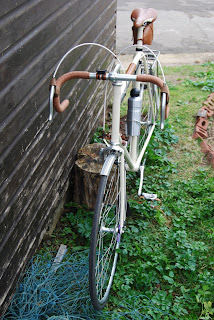I'm being narratively selective here of course: my late teens and early twenties were spent walking, cycling, running and climbing and I had a healthy, fit lifestyle too. I discovered rock climbing and realised that basic cardiovascular fitness and strength could enhance my performance, achievements and subsequent pleasure. I also discovered the value of good nutrition and became adept at choosing food and drink that could be carried easily in a small rucksack!
In a moment of hubris I attempted a climb a bit beyond me. I fell, my protection unzipped and I landed feet first on a boulder and broke all three bones in my ankle. So aged 23 I could not run, found walking painful, and could not climb to any decent standard. So I started scuba diving, not exactly high intensity work. Looking back, I don't think I did any significant cardiovascular exercise for about twenty years when I rediscovered cycling, but only as a commuter in London. I flirted with the YMCA gym but it was a one sided affair and we split up after a year.
Last year I took the decision to train for and complete a cycling century. I used a fabulous book: The Complete Book of Long Distance Cycling, to inform my carefully graded rides and to prepare food and drink. I had a eureka moment when I found some research by a Spanish doctor who found that beer was the perfect carbohydrate replenishing drink after a hard ride.
The next comment is not bragging but a testament to the training and nutrition I got from the book. I found it easy. I averaged 14mph, took it easy and enjoyed every minute. In a bizarre way I felt a bit cheated. No anguish I pushed myself through, no burning pains I forced myself to endure, and no bonk ( the enervating result of poor nutrition ).
Where to from here then? I felt that the time needed for a double century would be too intrusive into family life and professional obligations. I'd just become aware of fixies and built a very crude one for winter riding. The unexpected happened and I became fixated (!) on riding longer and longer distances. The outcome was obvious: a fixed gear century.
The training for last year largely consisted of working within carefully constrained pulse rates so as to increase endurance and efficiency without depleting energy stores. Cardio vascular work was an almost completely separate programme and developed heart and breathing efficiency together with muscle tone and strength. With a geared bike it's relatively easy to separate out these factors and concentrate on one aspect: if your heart rate goes beyond your zone just drop a gear and go slower or free wheel a bit! If you need to push your rate into the cramp zone then raise a gear and push hard. Not so easy on a single gear. I'm getting to know the topography of North Norfolk very well. All my training rides need to be planned around hills and flats so I can at least have a basic model of what I'll be improving. What I am finding is that I'm very quickly learning to relax in punishing situations. To get a reasonable downhill speed you need to get a cadence of 120 or 130. Something like this:
It takes a lot to convince your body that you can relax!
One of the upshots of last year's efforts was the realisation that I was basically, and despite various leg injuries, quite fit with the maximum HR of a 45 year old. I'm now proselytising about teenage fitness to my pupils and children!
I'm also revisiting some skills I learned when beginning to dive. It's amazing how far you can swim on one breath if you can completely relax.
So at the moment it's a case of trying to keep smooth, controlled and within heart rate zones, increase times and distances and maintain comfort.
What to eat and drink? Shops and magazines would have you spend fortunes on bars and gel and drinks and powders. After a bit of web research I found some recipes for energy drinks and tried a couple. I now swear by a combination of Lady Grey tea, lemon juice, brown sugar and cardamom pods with a pinch of salt. I drink this fairly concentrate for the first two or three hours, (every 15 mins!!) and then dilute it further with cold water for the rest of the ride.
Food was a bit more of a problem: I got heartily sick of sweet stuff and long distance cyclist Dave suggested marmite sandwiches. Have yet to try these but I think they'll supplement the homemade flapjacks really well. The Really Important Thing is to keep eating and drinking.
And finally, despite Lance Armstrong, it is a bit about the bike!
I stripped down my old custom built Bob Jackson frame, had it powder coated, bought some second hand track wheels from my lbs, made some leather bits and pieces and trawled the internet for various cheap but gorgeous bits, rode it a couple of weeks and realised I could drop a gear to make it that bit easier on the flats and downhill. I'll keep this updated as I approach the Suffolk Sunrise century on May13th.
Next year, the Goodwood 24hrs beckons...........







